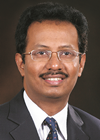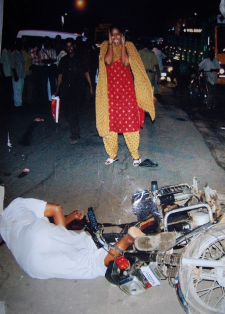SICOT e-Newsletter
Issue No. 70 - October 2014
 Editorial by S. Rajasekaran - SICOT Treasurer
Editorial by S. Rajasekaran - SICOT Treasurer
Road Safety Through Legal Advocacy - The Indian Experience'The next best thing to creating life is to save one'
The rising incidence of road traffic accidents is a cause of serious concern worldwide. While this is a global concern, the situation is particularly alarming in India as the country has earned the dubious distinction of having the highest number of road traffic accidents in the whole world. The recent WHO Global Safety Report 2013 states that India has a high fatality rate on roads, losing 100,000 lives to road crashes every year (139,091 in the year 2012), with a fatality rate of 10.83 deaths per 100,000 population (World Road Statistics data, 2011). The numbers have only increased since 2011 and a look at the following numbers will elaborate the gravity of the situation.
- There is one recorded road traffic accident death every five minutes. The number may be more as many deaths in the rural areas of the country are not recorded accurately.
- Approximately 700,000 people are seriously injured with major disabilities which require prolonged hospitalisation and surgery. Many of them are permanently disabled and have to alter their lifestyle.Â
- 85% of the victims of these fatalities are men in the age group 20-50 years. The majority of these men are the breadwinners for their families.Â
- The cost of primary treatment of all road traffic accidents in the country is Rs.7 lakh Crores. This almost amounts to 3% of the country's GDP.Â
- More than 80% of the road accident victims are uninsured and hence have to pay the treatment cost from their own pocket.
- There is no streamlined process of support to the disabled victims by means of Government social security.
- Government statistics show that in the last couple of decades, the number of road accidents has increased by 4.4 times, accompanied by a 9.8 times increase in fatality and 7.3 times increase in the number of persons injured.
The root cause of the malady is manyfold and the predominant issues include poor quality of road infrastructure, vehicles that are poorly maintained, inadequate training of drivers and poor enforcement of laws with respect to road safety. The mammoth increase in the population and the registered number of vehicles has hardly been matched by the increase in the road network in India. Though there has been more than a 100-fold increase in the number of registered motor vehicles, there has only been a four-fold increase in the road network. There is also the problem of a high number of pedestrians and two wheelers on the Indian roads and the general tendency for poor compliance to road safety rules and laws.
Overall, the situation is so alarming that WHO mentioned 'the dream of India to be a super power is evaporating on its roads'. Central to the whole problem is the Government's apathy to the whole issue. The issue of road safety falls into the ambit of many departments and unfortunately the principle of 'Everybody's responsibility is nobody's responsibility' prevailed.
Taking cognizance of this grave situation, Dr Rajasekaran, as the President of the Indian Orthopaedic Association, approached the Supreme Court with a Public Interest Litigation against the Office of the Prime Minister and six principle Departments and Ministries concerned with road safety alleging callousness and dereliction of duty on this important safety issue. In particular, it was argued that a huge number of the citizens of the country are being injured and disabled for no fault of their own due to errant drivers and poor enforcement of road rules. This left them completely disabled and robbed them and their family of livelihood and happiness. This was against the 'fundamental right to live and to live to the fullest ability'. A right that was promised to each citizen by Article 21 of the Constitution of the country.
The Public Interest Litigation was admitted for hearing by the Chief Justice of India and was heard by a bench comprising of Justice P. Sathasivam, Justice Ranjan Gogoi and Justice N.V. Ramana. After sixteen months of hearings and deliberations, the Honourable Court accepted the Prayers of Dr S. Rajasekaran and have ordered the setting up of a Supreme Court Empowered Committee consisting of a Judge of the Supreme Court, Retired Secretary of the Department of Surface Transport and a Social Activist to look into the road safety issues and form guidelines for all the states to follow. The Government has accepted the recommendations and has agreed to the setting up of the 'Road Safety Authority of India' which will be an independent, legally empowered and fully functional agency accountable directly and only to the Central Parliament. The Road Safety Authority will look into all issues of road safety from education, enforcement and engineering and report to the Supreme Court every six months on the progress and compliance of the Government on all important issues. Some of the immediate provisions are listed in the Table.
Taking cognizance of this grave situation, Dr Rajasekaran, as the President of the Indian Orthopaedic Association, approached the Supreme Court with a Public Interest Litigation against the Office of the Prime Minister and six principle Departments and Ministries concerned with road safety alleging callousness and dereliction of duty on this important safety issue. In particular, it was argued that a huge number of the citizens of the country are being injured and disabled for no fault of their own due to errant drivers and poor enforcement of road rules. This left them completely disabled and robbed them and their family of livelihood and happiness. This was against the 'fundamental right to live and to live to the fullest ability'. A right that was promised to each citizen by Article 21 of the Constitution of the country.
The Public Interest Litigation was admitted for hearing by the Chief Justice of India and was heard by a bench comprising of Justice P. Sathasivam, Justice Ranjan Gogoi and Justice N.V. Ramana. After sixteen months of hearings and deliberations, the Honourable Court accepted the Prayers of Dr S. Rajasekaran and have ordered the setting up of a Supreme Court Empowered Committee consisting of a Judge of the Supreme Court, Retired Secretary of the Department of Surface Transport and a Social Activist to look into the road safety issues and form guidelines for all the states to follow. The Government has accepted the recommendations and has agreed to the setting up of the 'Road Safety Authority of India' which will be an independent, legally empowered and fully functional agency accountable directly and only to the Central Parliament. The Road Safety Authority will look into all issues of road safety from education, enforcement and engineering and report to the Supreme Court every six months on the progress and compliance of the Government on all important issues. Some of the immediate provisions are listed in the Table.
|
It is said that 'The next best thing to creating life is to save one'. As orthopaedic surgeons, we have confined ourselves too long to just treating road traffic accident victims. However, even with the best of our ability, too many people die and many more are permanently disabled. It is important that we play an active role of advocacy against road traffic accidents. The Indian experience shows that it is indeed possible.

A wife in grief on seeing her husband run over in front of her eyes. Can we join hands to stop this tragedy?